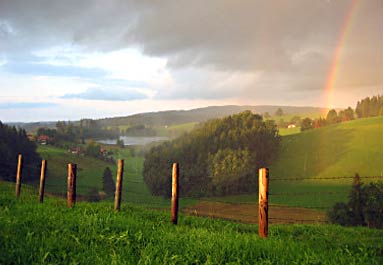This original column is provided free for one-time use with author credit at the end. It may be used for background with author credit. Copyright applies.
#17 FOR IMMEDIATE RELEASE: January 3, 2008
Whatever happened to acid rain?
By Curtis Seltzer
BLUE GRASS, Va.—Two decades ago – even ten years ago – acid raid was commonly accepted as one of America’s most pressing environmental problems. Presidential candidates back then talked about wilderness lakes being too acidic to support fish and New England forests dying from elevated nitrogen and sulfate concentrations generated by coal-burning power plants in the Ohio River Basin. Water supplies and trout populations were being affected. Acid precipitation promised to dissolve stonework and statuary. The fine particulates of sulfates and nitrates along with nitrogen-related, ground-level ozone (smog) were associated with tens of thousands of premature deaths and illnesses.
Current monitoring data show that rain over most of the eastern half of the U.S is still acidic, but increasing less so. Most of the western U.S. does not have acid rain. pH is a logarithmic scale, 0 to 14, that shows acidity between zero and 7.0, neutral at 7.0 and basic (or alkaline) between 7.0 and 14. Acidity increases from 14 to zero; alkalinity increases from 7 to 14. A change of one unit on the scale, say from 5 to 4, indicates that the pH of 4 is ten times more acid than the ph of 5.
Stomach acid has a pH of 1.4; lemon juice is 2.4; tomatoes are 4.2; water exposed to air is 5.5; pure water is 7.0, baking soda is 8.4 and household bleach is 12.5. “Acid rain” has a pH of less than 5. (http://bqs.usgs.gov/precip/reports/arfs.htm.) The federal National Atmospheric Deposition Program (NADP) operates a network of more than 250 monitoring sites in 49 states, located predominately away from urban areas and point sources of pollution. Each collects a weekly sample for acidity, calcium, magnesium, sodium, potassium, sulfate, nitrate, chloride and ammonium.
National maps show the concentration patterns of these substances. Click on 2006 annual summary for the most recent data. Or view the year-to-year trend data for each of the now 253 monitoring sites. Click on 'retrieve data for all sites', then click on 'annual data'.
In 2006, 126 sites recorded average lab pH of 5 or greater while 127 showed less than 5 Precipitation west of the Mississippi River overall is less acidic than that East of the River. Three sites -- one each in California, Utah and Colorado – recorded an average pH of more than 6 in 2006. These were the least acidic recordings in the country. West Virginia’s three sites had the highest acidity of any state. They ranged between 4.40 and 4.45 pH. West Virginia rain is a little less acidic than a tomato. Virginia’s eight sites ranged between 4.54 and 4.84, all categorized as acid rain.
Precipitation has become less acidic in most places between 1983 and 2006. States where rain continues to be acidic (less than 5 pH) are Delaware, Connecticut, Georgia, Indiana, Louisiana, Maine, Maryland, Massachusetts, Michigan, Missouri, Mississippi, New York, New Hampshire, New Jersey, North Carolina, Ohio, Pennsylvania, South Carolina, Tennessee, Vermont, Virginia, West Virginia and the District of Columbia. Ten randomly selected sites east of the Mississippi showed pH generally in the mid-4 range in 1983 with a decrease in acidity of 0.l0 to 0.50 between l983 and 2006.
The most acidic site in this group was a central Pennsylvania station that showed a pH of 4.17 in 1983 and 4.39 in 2006, a decrease in acidity but still among the most acidic sites in the country. Two sites in this group – one in southwest Virginia and the other in southern West Virginia – showed a slight worsening in acidity in the two bookends of that 23-year span. The Virginia site recorded a 4.62 pH in 1983 and 4.60 in 2006; the West Virginia station showed 4.60 pH in 1983 and 4.45 in 2006.
What explains the general decrease in acid rain across the country since the 1980s, and particularly in the pollution-heavy, Illinois-to-New-York belt? The simple answer is that less sulfur dioxide (SO2) and oxides of nitrogen (NOx) were being put into the air by the coal fired, electric utility boilers that the federal Acid Rain Program (ARP) regulated. In 1996, 837 facilities (with 2,317 units) emitted about 12.5 million tons of SO2, 6 million tons of NOx and 2.23 billion tons of carbon dioxide (CO2) to produce about 22.7 billion mmBtus of heat. A decade later, 1,213 facilities (with 3,484 units) had reduced SO2 to 9.4 million tons and NOx to 3.41 million tons while generating 26.8 billion mmBtus. But CO2 rose to 2.49 million tons. For the first nine months of 2007, Click Here. (Click on the “Emissions” tab, then “Preliminary Quick Report” for the first nine months of 2007.)
With the exception of southern Texas and southern Florida, concentrations of sulfate (SO2 and other sulfur compounds) have decreased across the Lower 48. Nitrate concentrations have decreased east of the Mississippi River, most notably in the Mid-Atlantic states, but have increased in much of the Great Plains and Rocky Mountain states, according to Van Bowersox, past coordinator of the NADP at the University of Illinois. Electric utilities and industry are using cleaner coal to come into compliance. Low-sulfur coal has replaced high-sulfur coal. More smokestack gas is cleaned and more of it is cleaned better than 25 years ago. Much of the continuing pollution comes from old plants that were not required to install new control technology.
Federal air-pollution clean-up regulations have worked. The federal Acid Rain Program allows utilities to buy, sell or bank “allowances,” each one of which represents a one-time-only permit to emit one ton of SO2 during or after a specific year. A cap on allowances is imposed, which restricts overall SO2 emissions. The federal goal for 2010 is to reduce annual SO2 emissions from the ARP’s coal-fired boilers by ten million tons below the 1980 level of about 17.26 million tons. That requires a further reduction of only 2.2 million tons in annual SO2 emissions three years from now.
The Acid Rain Program has more than achieved its goal of reducing NOx emissions to 6.1 million tons in light of 2006’s emissions of 3.41 million tons. A 2005 U.S. Environmental Protection Agency program – Clean Air Interstate Rule – focuses on further reductions in SO2 and NOx from coal-fired utilities in 28 eastern states. (State goals can be found at http://www.epa.gov/CAIR/where.html.) Related programs have been adopted to reduce mercury and fine particulate (which degrades visibility). Unlike SO2 and NOx, no emission-reduction target has been set for CO2—one of the greenhouse gases that contributes to global warming.
The last decade of improvement in acid rain may represent both real change and the plucking of the lowest-hanging fruit. As America’s population increases, achieving further reductions in SO2 and NOx may prove to be both more difficult and more expensive than earlier reductions. When America’s monitoring sites show pH consistently above 5 across the country, acid rain will have become a solved problem. The good news for the first week of 2008 is this: America’s rain has become, and continues to get, less acidic because of what we’re doing, while the hardest nuts – from Illinois to New York – are cracked but not broken.
Curtis Seltzer, land consultant, is author of How To Be a DIRT-SMART Buyer of Country Property at www.curtis-seltzer.com. He’s written on environmental issues and authored Fire in the Hole: Miners and Managers in the American Coal Industry.
Contact: Curtis Seltzer, Ph.D.
Land Consultant
1467 Wimer Mountain Road
Blue Grass, VA 24413-2307
540-474-3297
curtisseltzer@htcnet.org
www.curtis-seltzer.com
This original column is provided free for one-time use with author credit at the end. It may be used for background with author credit. Copyright applies.
|









